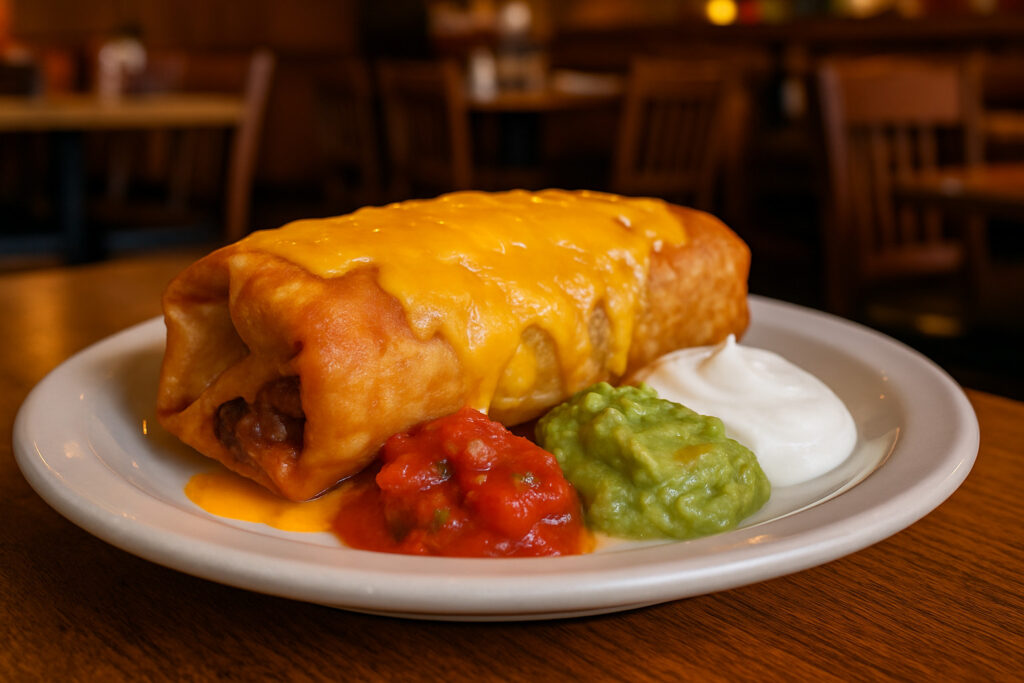Why the Chimichanga Became America’s Favorite Tex-Mex Creation
A chimichanga is a deep-fried burrito that delivers the perfect combination of crispy exterior and savory filling – making it one of the most beloved dishes in Tex-Mex cuisine.
Quick Chimichanga Facts:
- What it is: Deep-fried flour tortilla filled with meat, beans, rice, and cheese
- Origin: Arizona, 1920s-1940s (disputed between El Charro and Macayo’s restaurants)
- Cooking method: Deep-fried at 375°F until golden and crispy
- Serving style: Topped with salsa, sour cream, and guacamole
- Nutrition: ~443 calories per 6.5 oz serving
This crispy creation started as a happy accident in Arizona kitchens. The most popular legend credits Monica Flin of El Charro restaurant in Tucson, who allegedly dropped a burrito into hot oil in the 1920s and exclaimed “chimichanga!” instead of a Spanish curse word.
Unlike its soft burrito cousin, the chimichanga transforms ordinary ingredients into something extraordinary through the magic of deep-frying. The result? A golden, crunchy shell that gives way to warm, melted cheese and perfectly seasoned fillings.
Whether you’re exploring authentic Southwestern cuisine or planning your next culinary trip, understanding this iconic dish opens doors to one of America’s most creative food fusion stories.
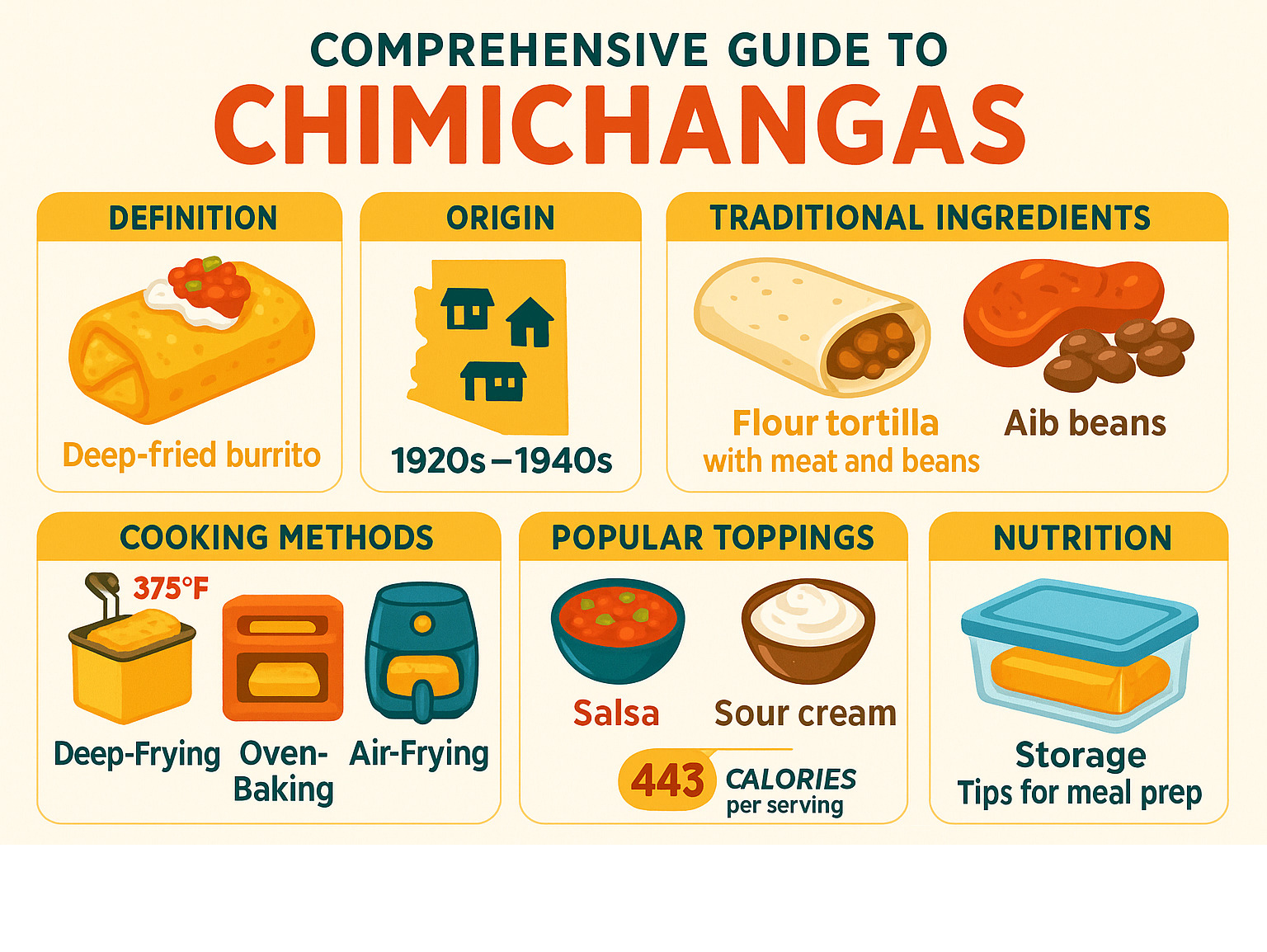
Quick chimichanga terms:
What Is a Chimichanga?
Picture this: you take all the delicious ingredients of a burrito – seasoned meat, creamy refried beans, fluffy rice, and melted cheese – wrap them snugly in a flour tortilla, then give the whole thing a hot oil bath until it emerges golden and crispy. That’s a chimichanga, and it’s pure Tex-Mex magic.
This deep-fried burrito has become a true staple of Southwestern cuisine, and once you bite through that shatteringly crispy exterior to reach the warm, gooey filling inside, you’ll understand why. The chimichanga delivers an incredible texture contrast that regular burritos simply can’t match.
What makes a chimichanga special isn’t just the frying process – it’s how that process transforms the entire eating experience. The flour tortilla becomes a golden, crunchy shell that holds everything together while you dig in. Inside, the cheese gets perfectly melty, the beans stay creamy, and the meat absorbs all those wonderful flavors.
You’ll typically find chimichangas served with cool toppings like salsa, guacamole, and sour cream on the side. These condiments can’t survive the deep-frying process, so they’re always served separately – which actually works perfectly since the contrast between hot and cold makes every bite more interesting.
Chimichanga vs Burrito
The difference between a chimichanga and a burrito really comes down to one game-changing step: that trip to the fryer. While burritos stay soft and can include fresh ingredients like lettuce and tomatoes mixed right into the filling, chimichangas get the deep-fry treatment that creates their signature golden crunch.
Burritos are wonderfully versatile – they can be served cold or hot, packed with almost any combination of ingredients, and come in wildly different sizes. Chimichangas, on the other hand, are more standardized. They’re always served hot, always crispy, and typically stick to heartier fillings that can handle the frying process.
The cooking method creates a texture contrast that’s completely different too. Burritos are soft throughout, while chimichangas give you that satisfying crunch followed by the warm, melted interior. Portion sizes tend to be more compact with chimichangas since they need to hold together during frying, whereas burritos can be loosely packed giants.
| Feature | Chimichanga | Burrito |
|---|---|---|
| Cooking Method | Deep-fried until golden | Served soft, sometimes griddled |
| Texture | Crispy exterior, warm interior | Soft throughout |
| Size | Often smaller and more compact | Can be larger, more varied sizes |
| Toppings | Served on the side | Often mixed into filling |
| Temperature | Always served hot | Can be served cold or hot |
Chimichanga vs Enchilada
While both dishes are beloved in Tex-Mex kitchens, chimichangas and enchiladas are completely different animals. Enchiladas use corn tortillas instead of flour, and they’re always sauce-smothered and baked in a dish rather than fried individually.
Think of enchiladas as the saucy, comfort-food cousin that gets rolled up and baked under a blanket of red or green chile sauce. Chimichangas are the crispy, handheld option that relies on that golden exterior for texture and keeps the sauces on the side.
The baking method versus deep-frying creates entirely different textures and flavors. Enchiladas are soft, saucy, and meant to be eaten with a fork, while chimichangas are crispy, portable, and perfect for picking up with your hands – though you might want some napkins nearby!
Origins and History of the Chimichanga
The chimichanga has one of the most delightful origin stories in American cuisine – complete with kitchen accidents, creative cursing, and a rivalry between two Arizona cities that continues to this day.
The most beloved legend takes us back to 1922 in Tucson, where Monica Flin was running her family restaurant, El Charro. Picture this: a busy kitchen, sizzling pans, and one fateful moment when Monica accidentally dropped a burrito into hot oil. As the tortilla began to bubble and crisp, she started to exclaim “chingada!” – a colorful Spanish curse word that definitely wasn’t appropriate for a family establishment.
Quick thinking saved the day. Monica caught herself mid-word and blurted out “chimichanga!” instead – creating both a new dish and a family-friendly name in one brilliant moment.
But Phoenix wasn’t about to let Tucson claim all the glory. Woody Johnson from Macayo’s restaurant tells a different story from 1946. His version involves the practical problem of leftover burritos and the clever solution of deep-frying them to extend their life. Johnson initially called his creations “toasted monkeys” before settling on the more appealing chimichanga name.

Both stories share something wonderful: the chimichanga wasn’t planned. It emerged from those spontaneous kitchen moments that create the best comfort foods. As one food historian noted, it might have been “some cook late one night, after a few too many tequilas” who decided that the only thing better than a burrito was a fried burrito.
The archived origin article from the Los Angeles Times explores these competing claims in fascinating detail.
Folk Tales & Name Etymology
The word “chimichanga” itself tells a story. It likely comes from the Tabasco region of Mexico, where “chivichanga” means something like “thingamajig” – a perfect name for Monica Flin’s accidental creation.
The etymology gets even more interesting when you break it down. “Chamuscar” means “to singe” in Spanish, while “changa” connects to mild profanity. Put them together, and you get a playful word that sounds much nicer than whatever Monica was about to say in that El Charro kitchen.
This linguistic creativity reflects the spirit of Tex-Mex cuisine itself – taking traditional elements and making them into something entirely new and wonderfully American.
Rise in Tex-Mex & Pop Culture
From those humble Arizona beginnings, the chimichanga conquered menus across the Southwest and beyond. By the 1950s, it had become such a staple that Tucson residents developed fierce loyalty to their “chimis” – preferring them large, overstuffed, and absolutely crispy.
The dish achieved legendary status when Arizona lawmakers tried to make it the official state food in 2011. While that effort didn’t succeed, it showed just how deeply the chimichanga had embedded itself in local culture.
Pop culture acceptd the chimichanga too, with references appearing everywhere from Deadpool comics (where it’s the character’s favorite food) to countless TV shows and movies. This crispy creation had officially made it from accidental invention to American icon.
The chimichanga’s journey mirrors the broader story of how immigrant cuisines evolve in America, creating something that’s both familiar and completely new. For more insights into how global flavors blend and transform, explore our guide to World Cuisine Exploration.
Ingredients & Traditional Preparation
Creating the perfect chimichanga starts with quality ingredients and proper technique. The foundation is always a large, thin flour tortilla – we recommend brands like Guerrero Burrito Flour Tortillas for their ability to achieve that perfect crispy texture without tearing during assembly.
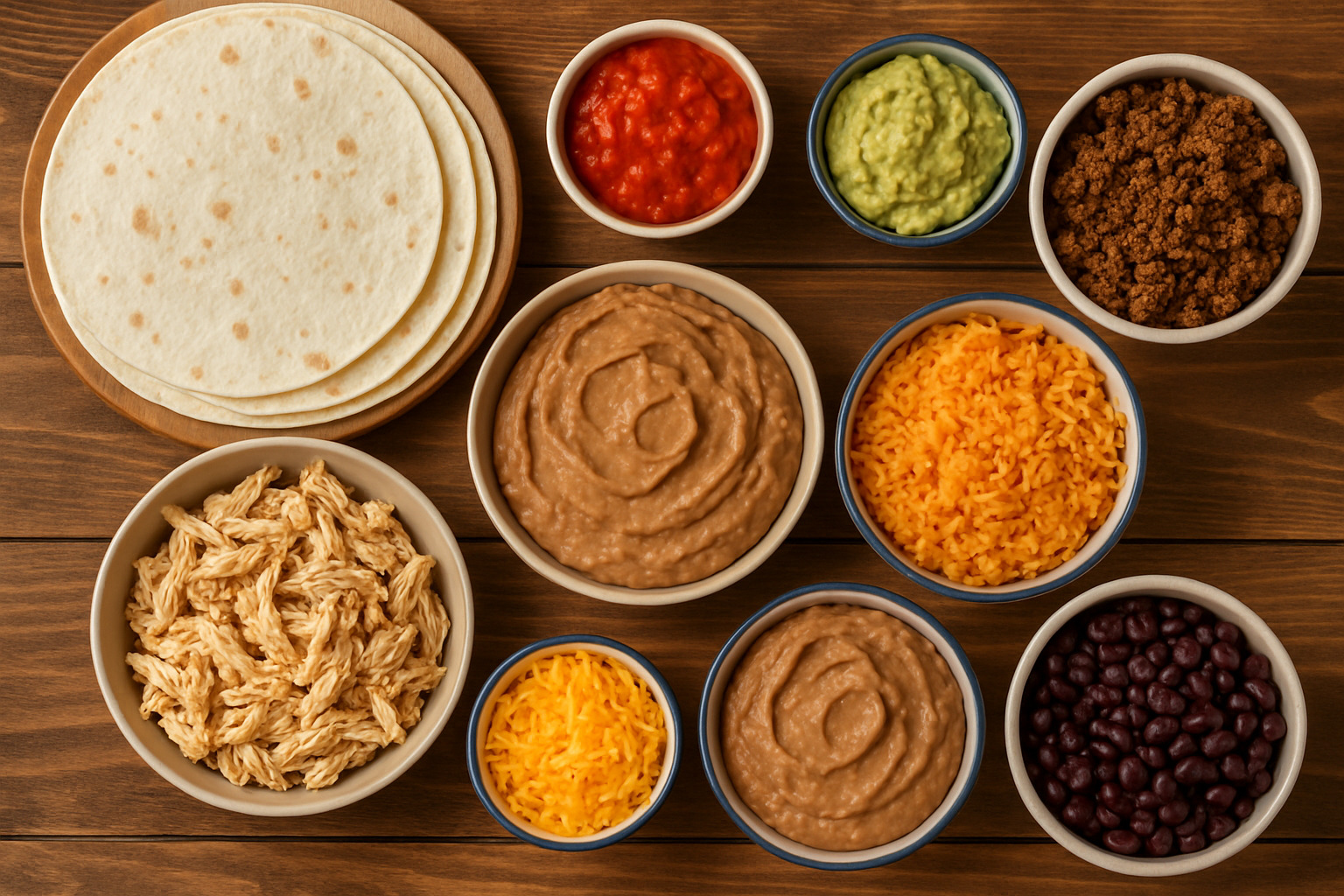
Essential Chimichanga Ingredients:
- Large flour tortillas (10-12 inches)
- Cooked protein (shredded chicken, beef, or carnitas)
- Refried beans or black beans
- Mexican rice or yellow rice
- Cheese blend (cheddar, Monterey Jack, or Chihuahua cheese)
- Seasonings: cumin, oregano, chili powder
- Green chiles (optional but recommended)
- Oil for frying (vegetable oil provides the most authentic flavor)
The key to a great chimichanga filling is balance. You want about 1/3 cup of rice per tortilla, enough protein to make it satisfying, and sufficient cheese to create that irresistible melt factor. The seasonings should be flavorful but not overpowering – remember, you’ll be adding sauces and toppings later.
Cooking Methods for Chimichangas
While traditional chimichangas are deep-fried, modern home cooks have developed several methods to achieve that coveted crispy exterior:
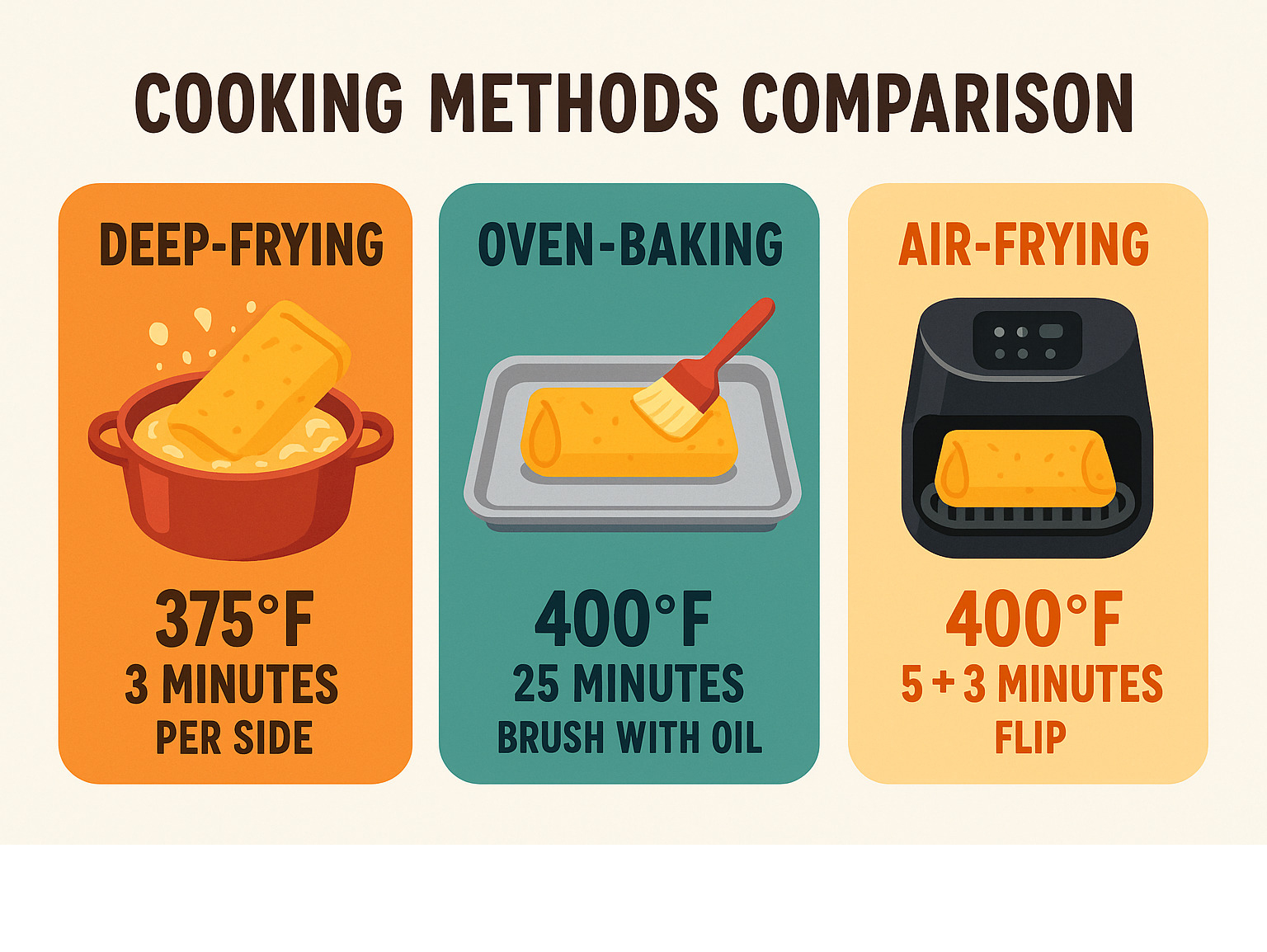
Deep-Frying (Traditional Method):
- Heat oil to 375-380°F in a heavy-bottomed pot
- Fry seam-side down for 2-3 minutes per side
- Results in the crispiest, most authentic texture
Oven-Baking (Healthier Option):
- Preheat oven to 400°F
- Brush chimichangas lightly with oil
- Bake for 25 minutes, flipping halfway through
Air-Frying (Modern Convenience):
- Set air fryer to 400°F
- Cook for 5 minutes, flip, then 3-4 more minutes
- Produces excellent crispiness with less oil
We’ve found that the air fryer method is our preferred technique for reheating leftover chimichangas, as it restores that crucial crispiness better than microwaving.
Step-by-Step Folding & Frying
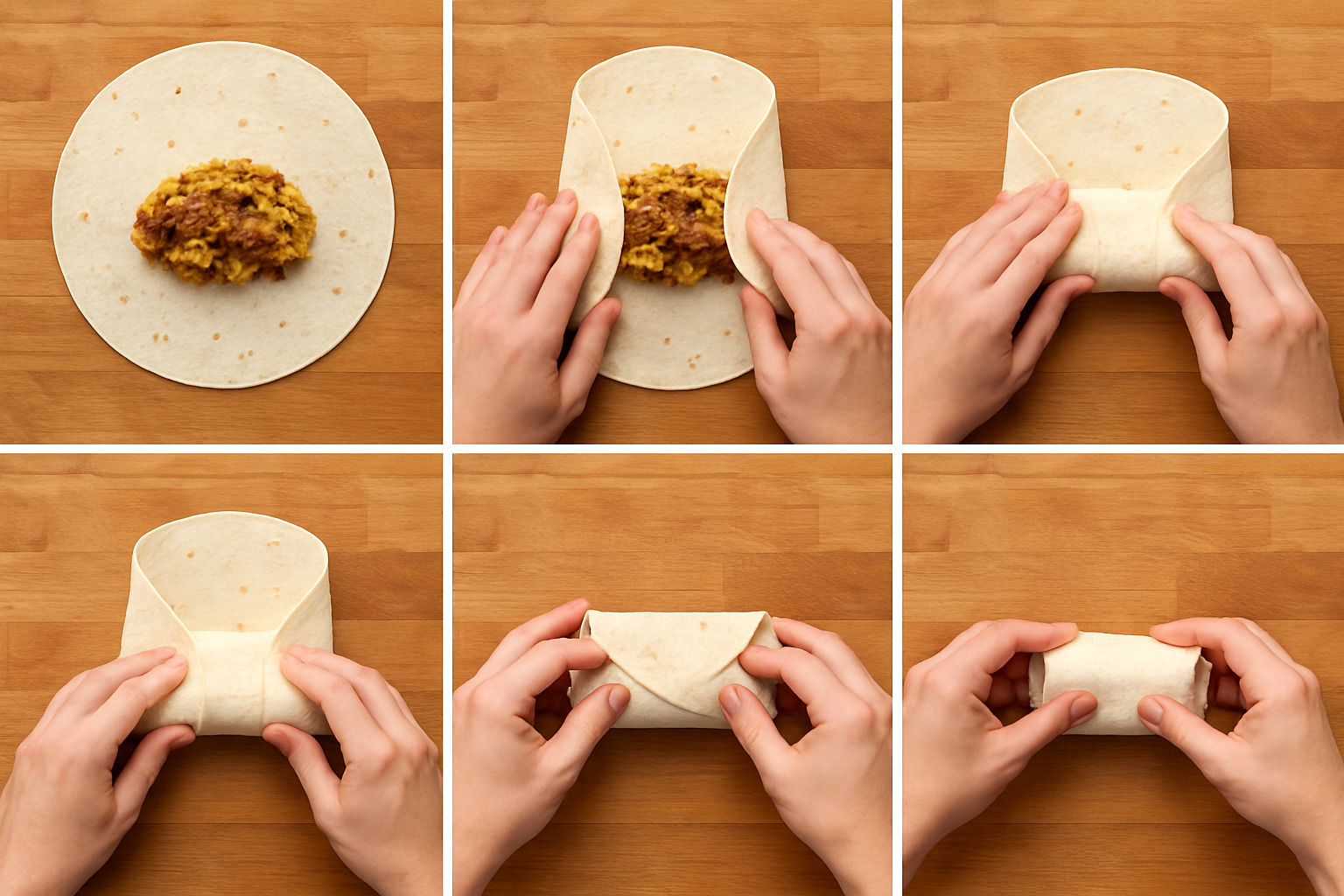
Proper folding technique is crucial for preventing filling leaks during cooking:
- Warm the tortilla gently until pliable (not cooked)
- Layer fillings in the center, leaving 2-inch margins
- Fold short sides in first, then roll tightly from bottom
- Secure seams with toothpicks if needed
- Place seam-side down when cooking to seal naturally
When deep-frying, maintain oil temperature between 360-380°F. Test readiness by dropping a small piece of tortilla – it should bubble and float immediately. Always drain on paper towels or a wire rack to remove excess oil.
Popular Fillings, Variations & Toppings
The chimichanga has evolved far beyond its humble origins as an accidental deep-fried burrito. Today’s creative cooks have transformed this crispy delight into a canvas for countless flavor combinations, from traditional Mexican favorites to surprising fusion creations.
Machaca beef remains the gold standard for authentic chimichangas – this dried, seasoned beef creates the perfect texture contrast against the crispy shell. Carnitas brings rich, slow-cooked pork flavor that pairs beautifully with the crunch, while classic shredded chicken offers a milder option that lets the seasonings shine through.
But modern chimichanga lovers aren’t stopping at tradition. Vegetarian black bean versions have gained serious popularity, especially when combined with sautéed peppers and onions. The beans provide protein and heartiness that makes even dedicated meat-eaters forget what they’re missing.
For those who love breakfast any time of day, breakfast egg chimichangas filled with scrambled eggs, chorizo, and cheese have become brunch favorites. The combination of crispy exterior and creamy eggs creates something truly special.
Perhaps most surprising are the dessert apple chimichangas – filled with cinnamon-spiced apples and served with vanilla ice cream, they prove that this cooking technique works magic on sweet fillings too.
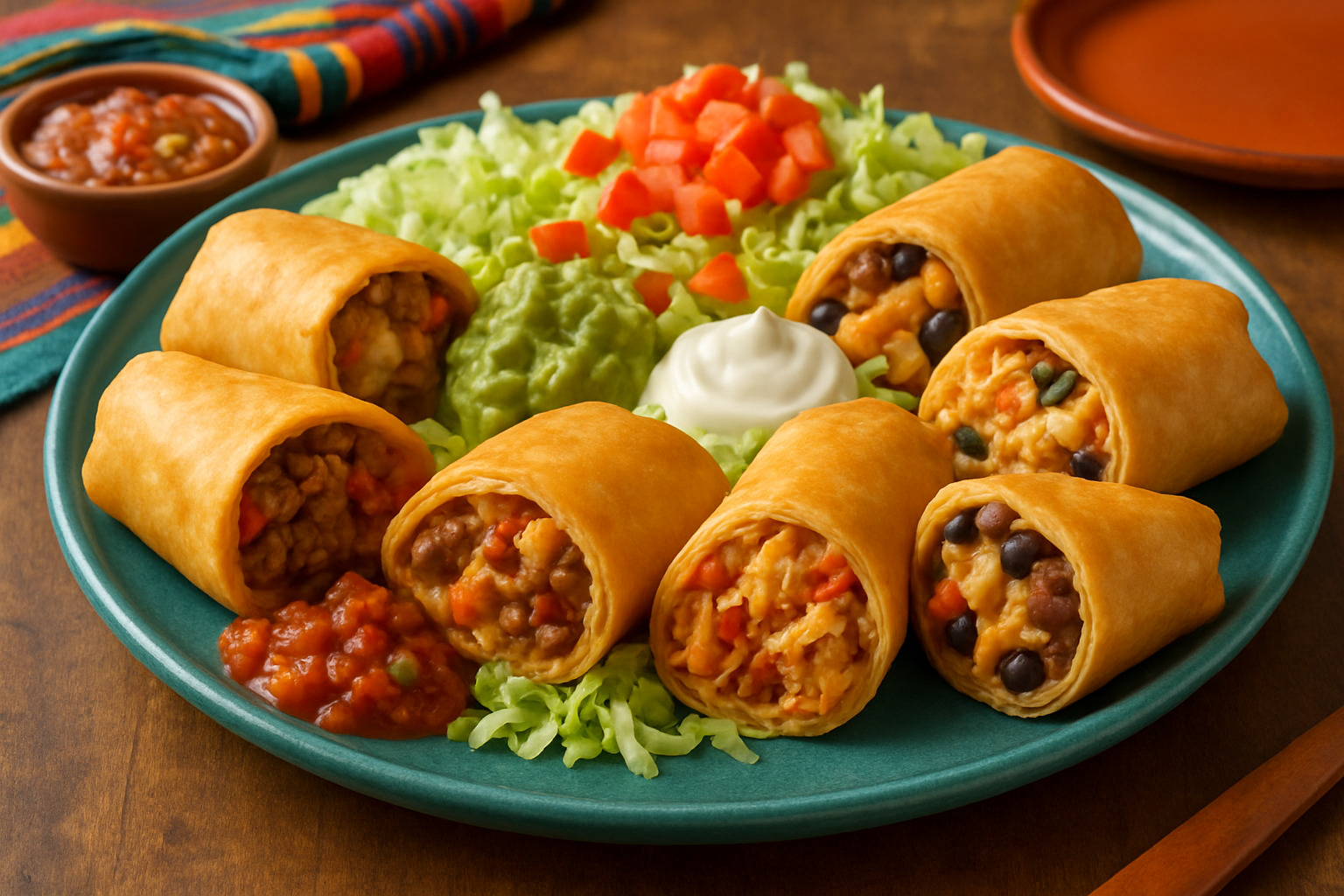
The fusion flavors movement has acceptd chimichangas with open arms. Teriyaki beef, jerk chicken, and even Korean bulgogi have found their way into these crispy packages, proving that good technique transcends cultural boundaries.
When it comes to toppings, the rule is simple: keep them cold and serve them on the side. Queso blanco provides creamy richness, while salsa verde adds bright acidity that cuts through the fried exterior. Fresh guacamole and sour cream are essential for cooling down spicier fillings.
The beauty of serving toppings separately is that each person can customize their experience. Some prefer their chimichanga naked to appreciate the crispy texture, while others load on every available topping for maximum indulgence.
For more inspiration on creative flavor combinations that are changing restaurant menus everywhere, explore our guide to The Flavor Fusion Trend.
Side Dishes to Serve
A great chimichanga deserves equally thoughtful sides, but the key is balance. Since chimichangas are rich and filling, the best accompaniments provide freshness and lighter flavors that complement rather than compete.
Mexican rice or cilantro-lime rice creates the perfect base – the rice soaks up any sauce that drips from your chimichanga while adding subtle flavor. We love how the lime brightens the entire plate and cuts through the richness.
Elote corn brings sweetness and crunch that contrasts beautifully with the soft interior of the chimichanga. The char from grilling adds a smoky element that improves the overall flavor profile.

Black beans seasoned with cumin and garlic provide protein and fiber while staying true to Southwestern flavors. They’re especially good for vegetarian chimichangas where you want to boost the overall protein content of the meal.
A fresh salad with lime vinaigrette offers a palate-cleansing element that’s especially welcome after rich, fried food. Keep it simple with lettuce, tomatoes, and perhaps some sliced radishes for extra crunch.
The goal is creating a plate that feels complete without overwhelming your guests. The chimichanga should be the star – these sides are the supporting cast that makes the whole meal memorable.
Nutrition & Dietary Adaptations
Let’s be honest – chimichangas aren’t exactly health food, but understanding their nutritional profile helps you enjoy them as part of a balanced diet. A typical 183-gram (6.5-ounce) serving of beef and cheese chimichanga packs quite a punch with 443 calories, 20 grams of protein, 39 grams of carbohydrates, and 23 grams of total fat (including 11 grams of saturated fat). You’ll also get 957 milligrams of sodium and 51 milligrams of cholesterol.
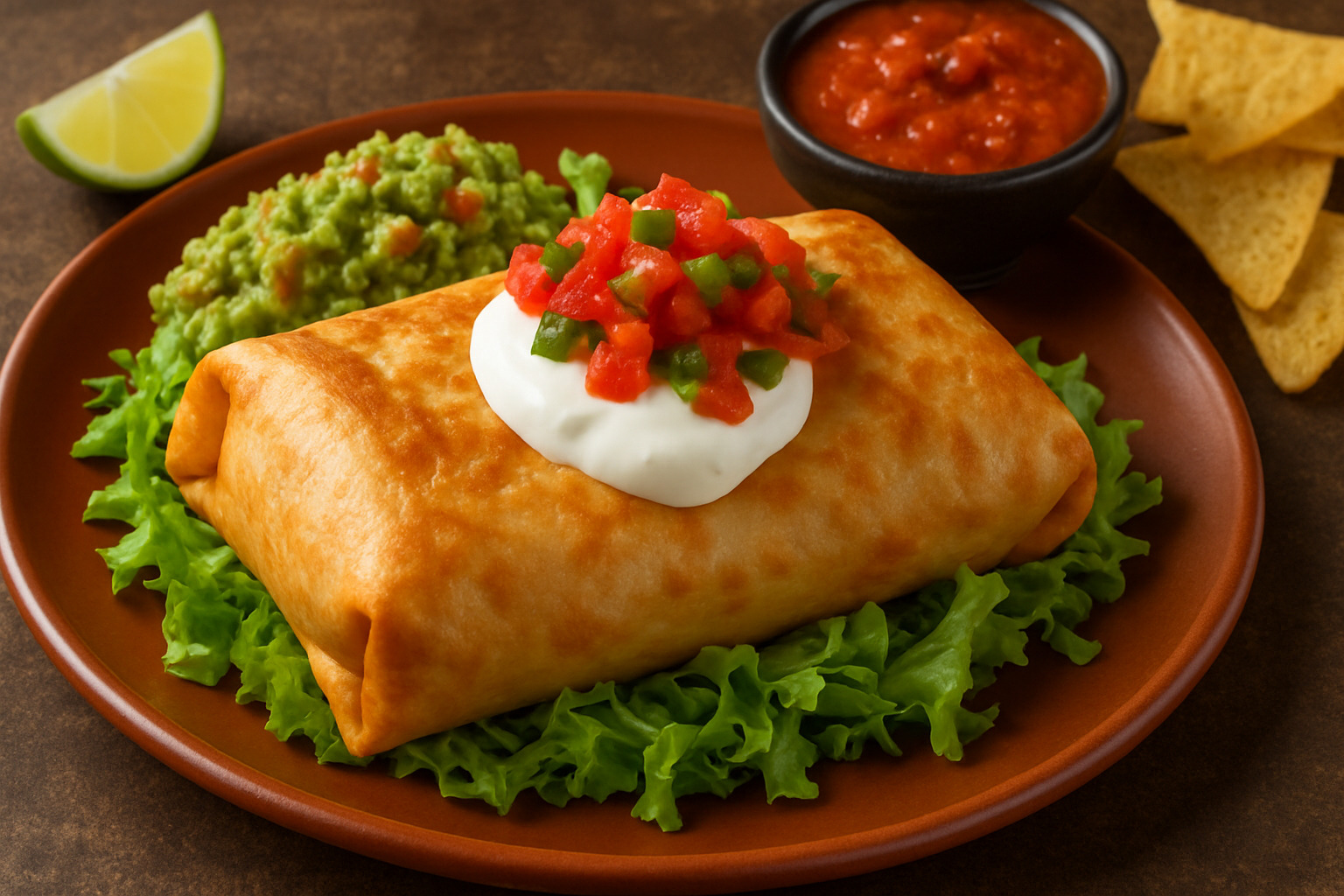
The good news? That high protein content means chimichangas are genuinely filling – you won’t find yourself hungry again an hour later. The less-than-great news is that most of those calories come from the deep-frying oil and melted cheese, which is exactly what makes them so delicious.
But here’s where it gets interesting: you have options. Baked chimichangas can reduce the calorie count by 30-40%, while air-fried versions dramatically cut the fat content without sacrificing that satisfying crispiness we all crave. When you make them at home, you gain complete control over ingredients and portions.
A homemade chicken chimichanga contains approximately 263 calories, 17 grams of protein, 7 grams of carbohydrates, and 17 grams of fat – substantially lighter than most restaurant versions. The difference is remarkable when you skip the commercial deep fryer.
For those with dietary restrictions, chimichangas are surprisingly adaptable. Vegetarian versions work beautifully with seasoned black beans, roasted vegetables, or plant-based proteins that crisp up nicely. Gluten-free tortillas make this dish accessible for those avoiding wheat, while homemade seasoning blends help control sodium levels. Even dairy-free versions are possible with the growing variety of plant-based cheese alternatives that actually melt properly.
Research shows that fried foods can impact heart health, so treating chimichangas as an occasional indulgence rather than a weekly staple makes sense for long-term wellness.
Storing & Reheating Chimichangas
The beauty of chimichangas extends beyond their crispy exterior – they’re fantastic for meal prep and leftovers when you know the tricks. Properly stored chimichangas keep in the refrigerator for up to 5 days in airtight containers, or you can freeze them for up to 3 months when wrapped individually in foil.
For meal prep enthusiasts, here’s a game-changer: assemble your chimichangas uncooked and refrigerate them for up to 2 days before frying. This lets you prep Sunday and enjoy fresh, crispy results throughout the week.
Reheating is where most people go wrong. The air fryer at 380°F for 3-4 minutes is absolutely the best method for restoring that crucial crispy texture. The oven works too – 350°F for 10-15 minutes – though it takes longer. The microwave heats quickly in 30-60 seconds, but you’ll lose all that beautiful crispiness that makes chimichangas special.
We can’t stress this enough: skip the microwave if you have any other option. That crispy shell is what transforms a regular burrito into something magical, and it’s worth the extra few minutes to do it right.
Frequently Asked Questions about Chimichangas
How do I keep chimichangas crispy?
The magic of a perfect chimichanga is all about that satisfying crunch when you take your first bite. The secret starts with maintaining your oil temperature between 375-380°F during frying – too cool and the tortilla absorbs excess oil, too hot and it burns before the inside heats through.
Once your chimichangas emerge golden and beautiful, resist the urge to stack them immediately. Instead, let them drain on paper towels or a wire rack to remove excess oil. This step is crucial because trapped oil will make them soggy.
Here’s where many people go wrong: never cover hot chimichangas with foil or lids. The trapped steam will turn that crispy exterior into a sad, soft wrapper faster than you can say “disappointing dinner.”
When it comes to reheating, your microwave is the enemy of crispiness. Instead, pop them in an air fryer at 380°F for 3-4 minutes, or use your oven at 350°F for 10-15 minutes. The air fryer method works like magic to restore that original crunch.
Can I make chimichangas ahead for meal prep?
Chimichangas are actually fantastic for meal prep – they’re like little packages of future happiness waiting in your freezer! You can assemble them completely and keep them in the refrigerator for up to 2 days before cooking, which makes weeknight dinners much easier.
For longer storage, wrap each chimichanga individually in foil and freeze them for up to 3 months. This individual wrapping prevents freezer burn and makes it easy to grab just what you need for dinner.
The best part? You can cook frozen chimichangas directly from the freezer without thawing. Just add a few extra minutes to your cooking time and you’ll have a crispy, hot meal ready in minutes. It’s like having your own personal Tex-Mex restaurant in your freezer.
Are chimichangas authentic Mexican food?
This is where the chimichanga story gets interesting! While they’re made with traditional Mexican ingredients like flour tortillas, beans, and spiced meats, chimichangas are actually a Mexican-American creation born in Arizona during the early-to-mid 20th century.
Think of chimichangas as part of the Tex-Mex family rather than traditional Mexican cuisine. They’re the delicious result of Mexican cooking techniques meeting American innovation – specifically, the brilliant idea that everything is better deep-fried.
If you travel to Mexico expecting to find chimichangas on every menu, you’ll likely be disappointed. While various regions have similar dishes, the deep-fried burrito style we know and love is distinctly American Southwest. It’s a perfect example of how immigrant communities adapt their traditional foods to new environments, creating something uniquely delicious in the process.
This doesn’t make them any less special – it just means they’re part of America’s rich food fusion story, where cultures blend to create new culinary traditions.
Conclusion
The chimichanga stands as one of America’s most delicious culinary accidents – a crispy testament to how the best dishes often come from unexpected moments in busy restaurant kitchens. From Monica Flin’s legendary “oops” moment in 1920s Tucson to today’s endless variations, this golden creation proves that innovation often happens when we least expect it.
What makes the chimichanga so special isn’t just its satisfying crunch or the way melted cheese stretches with each bite. It’s the story of adaptation and creativity that defines American cuisine at its best. Whether you’re team El Charro or team Macayo’s in the origin debate, we can all agree that whoever first dropped that burrito into hot oil gave us something truly wonderful.
The beauty of making chimichangas at home lies in their forgiving nature and endless possibilities. Start with the classic beef and cheese combination, then let your kitchen creativity run wild. Try breakfast versions with scrambled eggs, vegetarian black bean varieties, or even dessert chimichangas filled with cinnamon apples. The crispy exterior welcomes almost any filling you can imagine.
Don’t let the deep-frying intimidate you – remember that baked and air-fried versions deliver nearly the same satisfaction with less guilt. The key is achieving that perfect contrast between the crunchy shell and warm, flavorful interior that makes each chimichanga a little celebration on your plate.
For food lovers planning their next trip, experiencing authentic chimichangas in their Arizona birthplace offers a delicious glimpse into how regional American cuisines develop their own personality. Tucson’s oversized “chimis” tell a story about local pride and culinary identity that you simply can’t get from a chain restaurant version.
If this crispy journey has sparked your appetite for more food exploration, find amazing culinary destinations in our Best Food Travel Destinations guide.
At The Dining Destination, we believe that dishes like the chimichanga represent the beautiful chaos of American cooking – where accidents become traditions, and creativity transforms simple ingredients into something memorable. Now grab a tortilla and start your own chimichanga trip!

